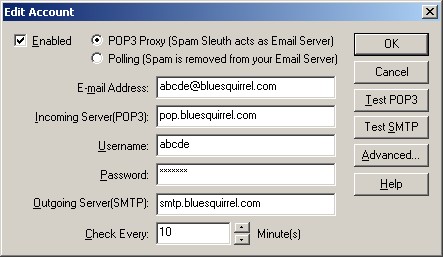| 
|
Enter the same information that you would enter into your e-mail program configuration. If you do not know what to enter, check the settings in your e-mail program, or contact your ISP.
POP3 Proxy vs. Polling Mode – This very important setting determines whether the program works in Polling-Mode or POP3 Proxy Mode. In Polling-Mode, Spam Sleuth removes spam from your server and leaves the good e-mail for your e-mail program to pick up. In POP3 Proxy Mode, Spam Sleuth will remove all the e-mail from your server and then becomes the POP3 server for your e-mail. POP3 Proxy Mode requires that you change the settings in your e-mail program to these settings: POP3 Server: localhost Username: <full e-mail address>
E-mail – Your e-mail address for this account.
Incoming Server (POP3) – The server name or IP address of your POP3 server.
Username – Usually this is the first part of your e-mail address (before the @ sign).
Password – The password you use to get your e-mail. You may leave this blank if you have POP3 Proxy turned on. Spam Sleuth will use the password provided by your e-mail program. If you check for e-mail manually with Spam Sleuth and the password is blank, you will be prompted for the password.
Outgoing Server (SMTP) – The server name or IP address of your SMTP server.
Check Every – This setting determines how often Spam Sleuth™ checks for spam.
Test POP3 – This button will show you the communication between Spam Sleuth and your POP3 Server. It logs on and quits. If you don't see any results, or you see –ERR, there is probably something wrong with Incoming Server, Username, or Password.
Test SMTP – This button will show you the communication between Spam Sleuth and your SMTP server. It starts to send an e-mail and then quits. If you don't see any results, or you see errors, there is probably something wrong with Outgoing Server, or your E-mail address.
Advanced – This button takes you to some additional settings including the port to use for the POP3 Proxy, and SMTP authentication settings if your ISP requires them.

